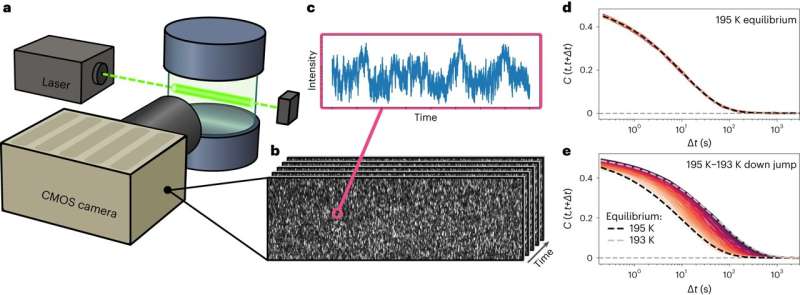This article has been reviewed according to Science X's editorial process and policies. Editors have highlighted the following attributes while ensuring the content's credibility:
fact-checked
peer-reviewed publication
trusted source
proofread
Physicists identify a surprising phenomenon of aging in materials over time

Physicists in Darmstadt are investigating aging processes in materials. For the first time, they have measured the ticking of an internal clock in glass. When evaluating the data, they discovered a surprising phenomenon.
We experience time as having only one direction. Who has ever seen a cup smash on the floor, only to then spontaneously reassemble itself? To physicists, this is not immediately self-evident because the formulae that describe movements apply irrespective of the direction of time.
A video of a pendulum swinging unimpeded, for instance, would look just the same if it ran backwards. The everyday irreversibility we experience only comes into play through a further law of nature, the second law of thermodynamics. This states that the disorder in a system grows constantly. If the smashed cup were to reassemble itself, however, the disorder would decrease.
You might think that the aging of materials is just as irreversible as the shattering of a glass. However, when researching the movements of molecules in glass or plastic, physicists from Darmstadt have now discovered that these movements are time-reversible if they are viewed from a certain perspective.
The team led by Till Böhmer at the Institute for Condensed Matter Physics at the Technical University of Darmstadt has published its results in Nature Physics.
Glasses or plastics consist of a tangle of molecules. The particles are in constant motion, causing them to slip into new positions again and again. They are permanently seeking a more favorable energetic state, which changes the material properties over time—the glass ages.
In useful materials such as window glass, however, this can take billions of years. The aging process can be described by what is known as the "material time." Imagine it like this: the material has an internal clock that ticks differently to the clock on the lab wall. The material time ticks at a different speed depending on how quickly the molecules within the material reorganize.
Since the concept was discovered some 50 years ago, though, no one has succeeded in measuring material time. Now, the researchers in Darmstadt led by Prof. Thomas Blochowicz have done it for the first time.
"It was a huge experimental challenge," says Böhmer. The minuscule fluctuations in the molecules had to be documented using an ultra-sensitive video camera. "You can't just watch the molecules jiggle around," adds Blochowicz.
Yet the researchers did notice something. They directed a laser at the sample made of glass. The molecules within it scatter the light. The scattered beams overlap and form a chaotic pattern of light and dark spots on the camera's sensor. Statistical methods can be used to calculate how the fluctuations vary over time—in other words, how fast the material's internal clock ticks. "This requires extremely precise measurements which were only possible using state-of-the-art video cameras," says Blochowicz.
But it was worth it. The statistical analysis of the molecular fluctuations, which researchers from Roskilde University in Denmark helped with, revealed some surprising results. In terms of material time, the fluctuations of the molecules are time-reversible. This means that they do not change if the material time is allowed to tick backwards, similar to the video of the pendulum, which looks the same when played forwards and backwards.
"However, this does not mean that the aging of materials can be reversed," emphasizes Böhmer. Rather, the result confirms that the concept of material time is well chosen because it expresses the entire irreversible part of the aging of the material. Its ticking embodies the passage of time for the material in question.
Everything else that moves in the material in relation to this time scale does not contribute to aging. Just as, metaphorically speaking, children playing around in the back seat of a car do not contribute to its movement.
The Darmstadt researchers believe that this generally applies to disordered materials, as they examined two classes of material—glass and plastic—and carried out a computer simulation of a model material—with the same results.
The physicists' success is just the beginning. "This leaves us with a mountain of unanswered questions," says Blochowicz. For example, it remains to be clarified to what extent the observed reversibility in terms of material time is due to the reversibility of the physical laws of nature, or how the ticking of the internal clock differs for different materials.
The researchers are keen to investigate further, so more exciting discoveries could lie ahead.
More information: Böhmer, T. et al, Time reversibility during the ageing of materials. Nature Physics (2024). DOI: 10.1038/s41567-023-02366-z
Journal information: Nature Physics
Provided by Technische Universitat Darmstadt




















